Invasive plants are non-native species that aggressively invade areas and displace native species. These plants may have been introduced by gardeners or transported from other countries by accident. Examples of invasive shrubs, vines, and trees commonly encountered at the Arboretum are shown below. These species are listed in the “Severe Threat” category by the Tennessee Exotic Pest Plant Council (tneppc.org/invasive_plants) and present management challenges as well as research opportunities. More detailed descriptions of these can be found by clicking on the individual links below.
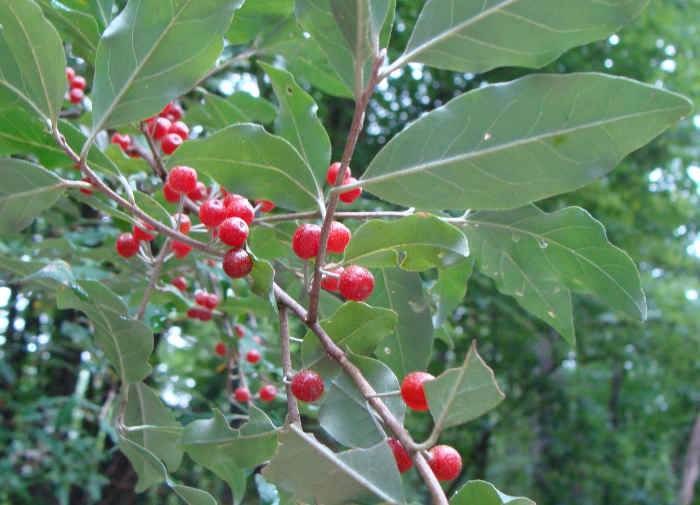
During the Dog-Days of summer (July and August), the red fruits of the invasive shrub Autumn Olive develop to maturity. Extensive growths of this shrub can be seen along the Cemetery Ridge Trail. Autumn Olive, a deciduous, alternate-leaved shrub, may grow as high as 20 ft. It’s distinctive oblong leaves are dark green above and silvery underneath, covered with distinctive silvery scales. The fragrant, pale white to yellow, tubular flowers produce abundant red fruits (dotted with silvery scales). These are eaten by a variety of birds and small mammals that distribute the seeds widely.
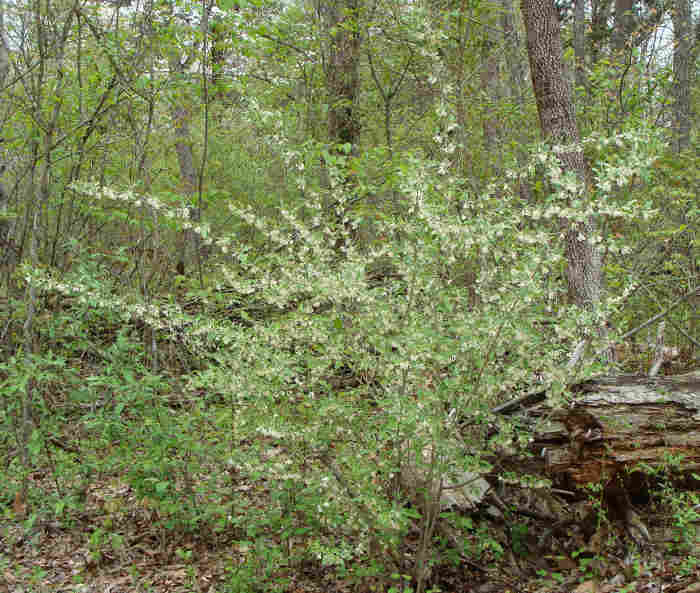
Eleagnus umbellata
A native of China and Japan, Autumn Olive was introduced into North America in the 1830’s. Initially it was planted as an ornamental shrub and was also used for strip-mine reclamation, windbreaks, and wildlife habitat. This shrub is highly invasive and is listed in the Severe Threat category by the Tennessee Exotic Pest Plant Council. The UT Forest Resources Center, in cooperation with UT faculty, has conducted research on testing of new herbicides to help eradicate Autumn Olive and other invasive, non-native plants.
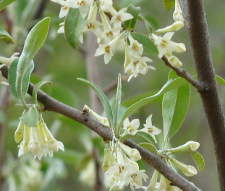
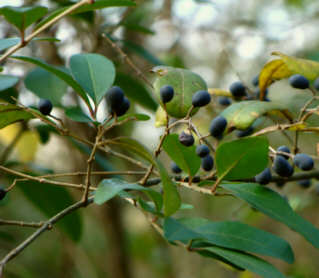
Chinese Privet, an invasive, non-native shrub or small tree, is found in a variety of habitats at the Arboretum, including wetlands, upland forests, and disturbed areas. It is a native of Southeast Asia that was introduced into the US as an ornamental in the mid-1800s and has subsequently spread throughout the East and Southeast. Once established, it produces vigorous root sprouts and can outcompete native species, completely taking over an area. Its abundant dark blue fruit is eaten by birds and other wildlife, and the seeds are widely dispersed by them.
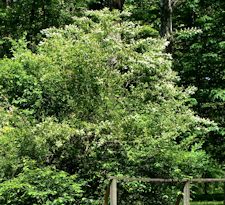
Ligustrum sinense
A member of the Olive Family (Oleaceae), Chinese Privet is semi-evergreen with opposite leaves, gray bark, and dense clusters of fragrant white flowers in the spring. At the Arboretum, it is especially conspicuous in forest edges along Arboretum Drive, Cemetery Ridge trail, and as scattered clumps along Scarborough Creek. It is difficult to control, as it rapidly sprouts back from roots and stumps when cut back. Its leaves have a high content of phenolic compounds that protect it from insects and other herbivores. The UT Forest Resources Center, in cooperation with UT faculty, is presently engaged in the testing of new herbicides to help eradicate privet and other invasive, non-native plants.
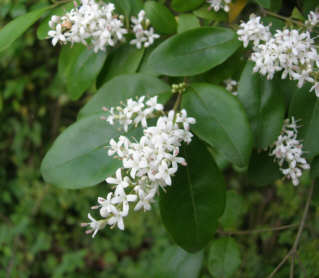
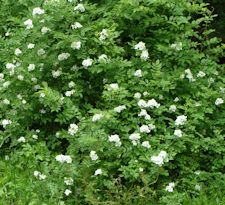
Rosa multiflora
From late April through the month of May and often well into June, Multiflora Rose is found flowering in a variety of habitats at the Arboretum. This invasive species has abundant, fragrant white flowers. The shrub is perhaps most conspicuous along the edges of forests, streams, and open areas. Its arching stems can develop into dense thickets, growing over native vegetation and becoming impenetrable due to the stout, recurved thorns along the branches.
The alternate, compound leaves have 5-11 leaflets with characteristic feathery stipules at their bases. The fruits (rose hips) develop in mid-summer and are eaten by a variety of birds and other wildlife, facilitating their dissemination. The UT Forest Resources Center, in cooperation with UT faculty, is presently engaged in the testing of new herbicides to help eradicate this shrub and other invasive, non-native plants.
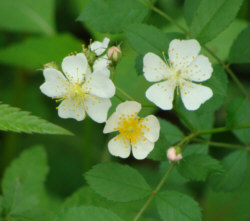
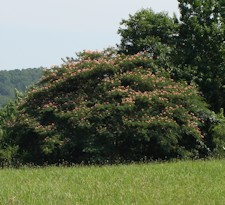
Albizia julibissin
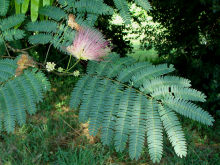
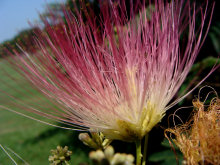
Silk Tree (commonly known as Mimosa) is found along highway and powerline rights-of-way, forest edges, and other disturbed areas. A native of Asia, it was introduced into North America as an ornamental during the 18th Century and is now considered an invasive plant – it is listed in the category “Severe Threat” by the Tennessee Exotic Pest Plant Council. A few trees occur at the Arboretum, but they have been managed as invasives and do not pose a significant problem. Silk Tree is a member of the bean family (Fabaceae) and has large twice-compound (bipinnate) leaves (up to 20 in. long); light to dark pink, thread-like flowers; and flat bean-like seed pods (5-7 in. long). The flowers attract hummingbirds, bees, and other insects. It is used as an ornamental throughout its range and has soil building properties related to nitrogen-fixing bacteria in its root nodules. Landscape ornamentals are susceptible to Mimosa Wilt which causes leaf yellowing and wilting in early and midsummer and results in death of the plants. Silk Tree produces abundant long-lived seeds, and it sprouts vigorously when cut back – features that promote its invasive character.
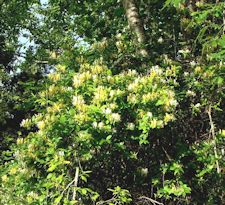
Lonicera japonica
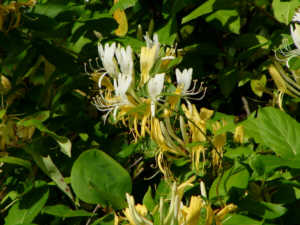
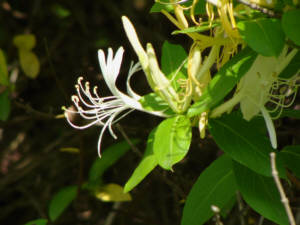
Japanese Honeysuckle is an exotic, invasive vine that is found along forest edges, fence rows, and in forest canopies. In May its very fragrant, white tubular flowers, which turn yellow with age, are borne in pairs at the leaf nodes. A long tube inside the corolla is filled with a honey-like nectar. Children enjoy removing the white blossom and sucking out the few drops of sweetness from the long inner tube thus the common name Honeysuckle.
A native of Japan and China, this vine can climb more than 30 ft and spread over a trees canopy to the point of shading it out and killing the tree. Its runners can also twist tightly around the stems of smaller plants and essentially strangle them by cutting off their supply of water through the xylem cells. Japanese Honeysuckle was introduced to the U.S. in the 1860s and has spread throughout much of the country.
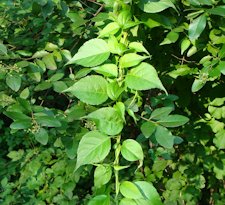
Celastrus orbiculatus
A walk along Cemetery Ridge Trail during our first snowstorm of the year (December 5, 2009) highlighted the bright red fruits of the Oriental Bittersweet vines that climb and, in some cases, cover some of the trees and shrubs along the trail. The fruits are initially green, but become bright yellow at maturity. When the yellow capsule breaks open in the fall, it reveals a fleshy red aril which contains two brown seeds.
The small greenish flowers develop in the spring (at the end of April this year). Each flower is typically unisexual either male or female, but some perfect flowers occasionally develop. The leaves are rounded to acute/elliptic, the latter shape being more common at the end of young developing shoots.
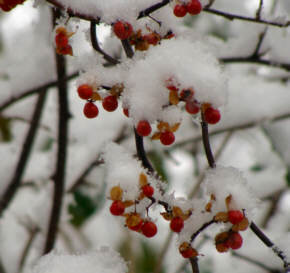
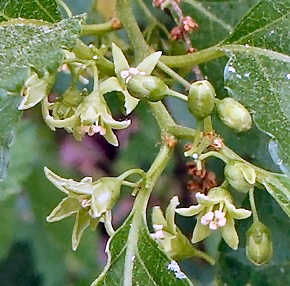
This invasive woody vine was introduced to the US in the mid- to late 1800s and is especially troublesome in New England, the Atlantic coastal states, and the southern Appalachians. The vine aggressively twines around tree and shrub stems and can strangle (by girdling) or completely covers and shades out its hosts. The fruits are eaten and spread by birds. People also inadvertently help spread the attractive fruits which they gather for holiday decorations. Such decorations should be destroyed completely after the holidays to limit the spread of this invasive plant. At the Arboretum, Oriental Bittersweet is most common in relatively open areas along forest edges and is one of several invasive plants the Arboretum staff is attempting to eradicate.
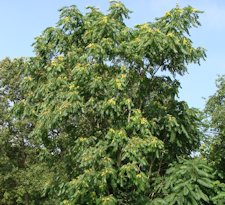
Ailanthus altissima)
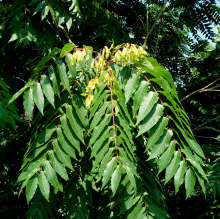
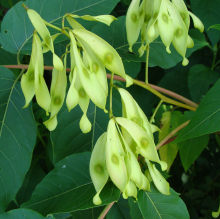
Tree-of-Heaven, a native of China, was first imported to Europe in the 1740’s and subsequently was widely planted in many European cities. It was brought to the US in the 1780’s and was planted as a street tree in many eastern cities because it is tolerant of smoke and soot and can thrive in poor soils. It gradually became naturalized and spread throughout much of North America. It is considered to be invasive in at least 30 states, including Tennessee where it is ranked as a ‘Severe Threat’ by the Tennessee Exotic Pest Plant Council. Tree-of-Heaven has alternate, very large (1-3 ft long), pinnately compound leaves with leaflets that have one or more glandular teeth near the base and no other teeth along their margins – a feature that distinguishes it from species of Sumac, Ash, and Black Walnut, all of which have teeth around the entire leaflet margins. This tree grows rapidly and reaches heights of 80-100 ft. It is dioecious, with small, pale yellow to greenish male and female flowers usually being borne on separate trees. It produces large numbers of flat, twisted, winged fruits, each with a single central seed. Its prolific production of seeds and its ability to sprout readily from roots after being cut back account for its invasive character. In addition, it is reported to produce toxic chemicals that inhibit the growth of other plants in its immediate vicinity. Tree-of-Heaven is not abundant at the Arboretum but is commonly seen along roads and greenways in the Oak Ridge area.
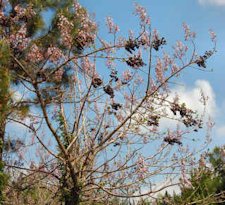
Paulownia tomentosa
Princess Tree (Royal Paulownia, Empress Tree), a native plant of China, was introduced into the U.S. in the mid 1800’s. It is found on Arboretum property but is more commonly seen along roadsides and disturbed sites throughout our region. Although still planted as an ornamental tree and used for reclamation of mine sites, it has become naturalized in many parts of the eastern U.S, and is considered an invasive species in many states, including Tennessee where it is listed as a severe threat by the Tennessee Exotic Pest Plant Council.
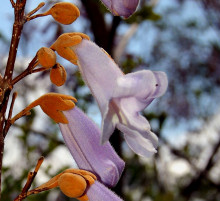
Although considered a member of the Figwort family (Scrophulariaceae) by many taxonomists, Princess Tree has recently been assigned to its own family, the Paulowniaceae. It produces upright clusters of pink to lavender flowers up to 2 in. long. The large leaves (5 to 26 inches long) are oval to heart-shaped and densely hairy (tomentose) beneath. In the fall, thousands of seeds are dispersed from the dry, brown capsules. Princess Tree reproduces by seeds and root sprouts and grows very rapidly (up to 15 ft. a year). Once established it is difficult to eliminate. The wood is in high demand in Asia for a wide variety of uses such as carvings, musical instruments, jewelry boxes, veneer, furniture, water pails, and spoons. In the 1970’s and 1980’s, the demand for this high value wood resulted in extensive commercial planting of Princess Tree in the US and other countries for export to Japan.
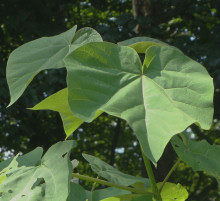
Please help us preserve our natural heritage!
No collecting of plant materials is permitted at the UT Arboretum.